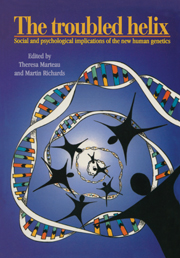Book contents
- Frontmatter
- Contents
- List of contributors
- Preface
- Preface to the paperback edition
- Acknowledgements
- Part I Personal stories
- Part II Clinical context
- Part III Social context
- 9 The troubled helix: legal aspects of the new genetics
- 10 Human pedigree and the ‘best stock’: from eugenics to genetics?
- 11 Public understanding of the new genetics
- 12 Families, kinship and genetics
- 13 Ethics of human genome analysis: some virtues and vices
- 14 Genetics and racism
- 15 Predictive genetics: the cultural implications of supplying probable futures
- 16 The new genetics: a feminist view
- 17 Afterword
- Index
9 - The troubled helix: legal aspects of the new genetics
from Part III - Social context
Published online by Cambridge University Press: 01 June 2011
- Frontmatter
- Contents
- List of contributors
- Preface
- Preface to the paperback edition
- Acknowledgements
- Part I Personal stories
- Part II Clinical context
- Part III Social context
- 9 The troubled helix: legal aspects of the new genetics
- 10 Human pedigree and the ‘best stock’: from eugenics to genetics?
- 11 Public understanding of the new genetics
- 12 Families, kinship and genetics
- 13 Ethics of human genome analysis: some virtues and vices
- 14 Genetics and racism
- 15 Predictive genetics: the cultural implications of supplying probable futures
- 16 The new genetics: a feminist view
- 17 Afterword
- Index
Summary
Sorcerers are too common; cunning men, wizards, and white witches as they call them, in every village, which, if they be sought unto, will help almost all infirmities of body and mind.
(Richard Burton, 1621, cited by Thomas (1973))Epistemology, ethics and genetics
Developments in genetics ‘pose challenging questions for the application of traditional legal principles’ (Kennedy and Grubb, 1993). This much was recognised, for example, at the Asilomar conference in 1975, where a group of molecular biologists recommended a moratorium on genetic manipulation while arrangements were made to regulate recombinant DNA techniques (Maddox, 1993). Without precedent, the scientific research community was inviting regulation from the legislature for its own activities. Indeed, writing in 1971 James Watson (the elucidator, with Francis Crick, of the structure of DNA) had suggested, of the possible developments in human reproductive research, that techniques for the manipulation of human eggs in vitro were likely to be in general medical practice, capable of routine performance in many major nations, within some 10 to 20 years, and that international agreement was a preferred method of control. On some matters there might even be ‘a sufficient international consensus… to make possible some forms of international agreement before the cat is totally out of the bag’ (Watson, 1971).
The particular difficulties that lawyers and ethicists will want to address are the functional analogue of the difficulties that the genome project discloses in general:
Physically, printing the names of the three billion base pairs would require the number of pages in at least thirteen sets of the Encyclopaedia Britannica, and this does not take into account the heterogeneity of human beings. […]
- Type
- Chapter
- Information
- The Troubled HelixSocial and Psychological Implications of the New Human Genetics, pp. 187 - 210Publisher: Cambridge University PressPrint publication year: 1996
- 4
- Cited by

